Despite the digital age we live in, calls as a means to drive sales isn’t going anywhere. And while Google Ads call-only ads and call extensions are one way to hit your target audience, how do you reach those who aren’t actively searching for you in Google?
If you know that calls are a sure-fire way of converting leads into customers, how do you both find these people, and encourage them to pick up the phone?
Well, it’s simple.
Facebook click-to-call ads.
Facebook’s solution for advertising can get your business and promotions in front of passive audiences at a reasonable cost. So let’s take a look at how Facebook click-to-call ads work and how you can measure them.
💡 Pro Tip
Are you struggling to match your Facebook and Google Analytics data? We reveal the most common reasons that lead to data inconsistencies between Facebook and Google Analytics and provide recommendations to help make your reporting more accurate.
Solving the data mismatch between Facebook and Analytics
Unlike general Facebook ads with a call-to-action that links to a website, brands can upload and integrate their business number directly into the advertisement.
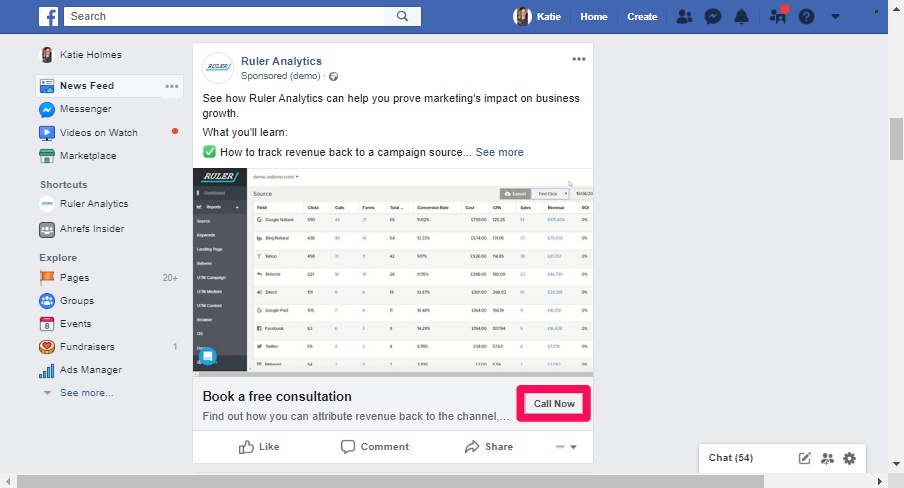
Facebook click-to-call ads have the specific CTA of “Call Now.”
When users click this button, the dial pad on the phones opens, pre-populated with your business number. This means that prospects can contact your business straight from the Facebook platform.

Just like any other ad on Facebook, click-to-call ads can be targeted to detailed personas and may display to people within a certain distance (ex: within a mile) of your business.
You might be thinking that click-to-call ads are a useless endeavour when the digital savvy generations can find all they need online.
But, that’s not true.
For small businesses, in particular, as many as 60% of customers prefer to call.
We’re glad you asked.
There’s no point getting your click-to-call ad up and running, without a way to measure its effectiveness.
While Facebook provides metrics on ad impressions, total spend, and how many people clicked the “Call Now” CTA, this doesn’t tell you whether those clicks resulted in any customers.
While the button drives a user to call you, there’s no guarantee a call was made. And even if it was, there’s also no guarantee the call resulted in a sale.
To truly measure how many calls Facebook click-to-call ads are driving value, you need a form of inbound call tracking software so that you can determine how many resulted in revenue for your business. And that’s where we can help.
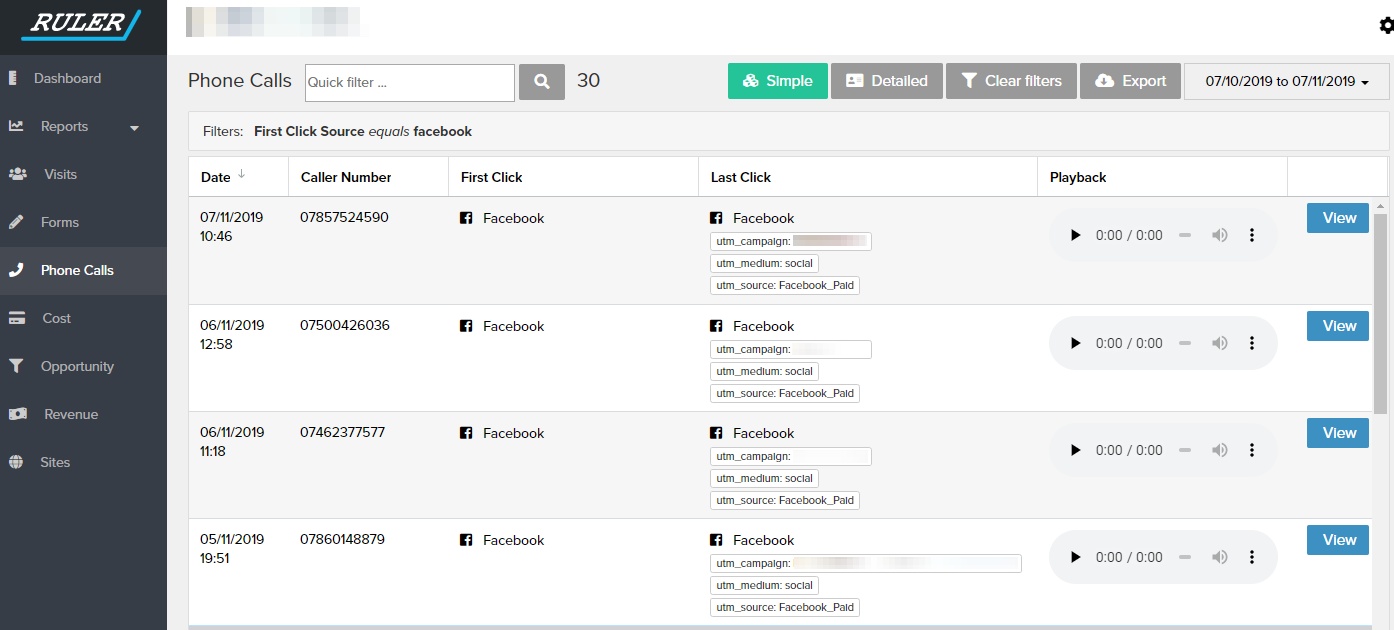
With software like Ruler, you can track phone numbers, record them and ultimately attribute CRM revenue directly to your Facebook campaign or advertisement.
Related: How Ruler attributes revenue to your marketing campaigns
By monitoring your revenue, you can get a good idea of whether or not your Facebook click-to-calls ads are working to help reach your goals.
Without an inbound call tracking system, it’s impossible to truly measure the quality of your leads. What you’re left with is guesswork and assumptions instead of a true picture of marketing ROI.
And remember, if you contribute to more than one area of marketing, then you might benefit from the closed-loop framework.
This allows you to attribute revenue back to the campaign, channel and keyword that generated it over multiple touchpoints.
💡 Pro Tip
Closed loop marketing is a game changer for marketers. It takes out the legwork and automatically connects your closed revenue to your marketing channels, campaigns, keywords and more.
Learn why you need closed loop marketing attribution
Now that we’ve explained what a Facebook click-to-call ad is and how to measure it, here’s how to set one up.
Step 1: Navigate to Facebook’s Ads Manager dashboard and select “Reach” in the “Awareness” column.
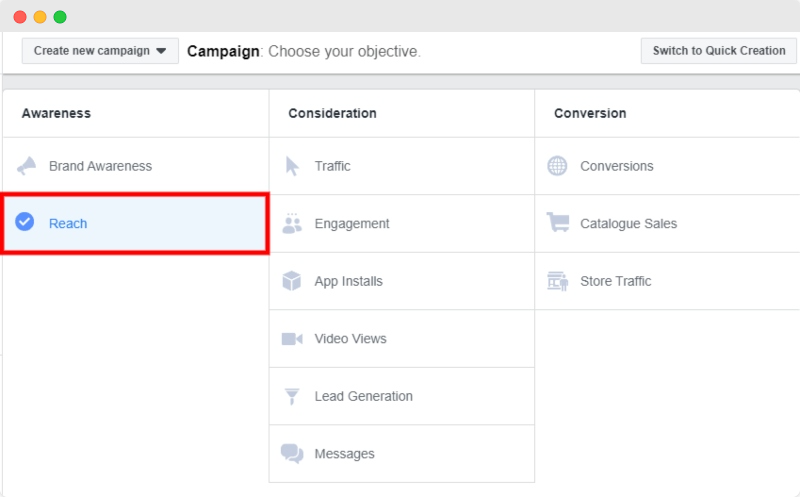
Step 2: Once you’ve named your campaign, upload your daily budget.

Step 3: Select your Facebook page and set up your target audience.

Step 4: Make sure you select “Manual Placements“.

Step 5: Hover over “Devices” and click “Edit“. Ensure that deselect “Desktop” and “TV“. In other words, “Mobile” is the option that should have a tick next to it.

Step 6: Deselect all platforms except for “Facebook“. Also, deselect all placements except for “Facebook Feed“.

Step 7: Now it’s time to create your ad. Select either”Carousel” or “Single image or video“.

Step 8: Create your ad copy, headline and description.

Step 9: You need a URL destination to setup click-to-call ads. If you don’t have a website you can just use your Facebook page URL. For example: www.facebook.com/ruleranalytics

Step 10: Select you call to action button “Call Now“.
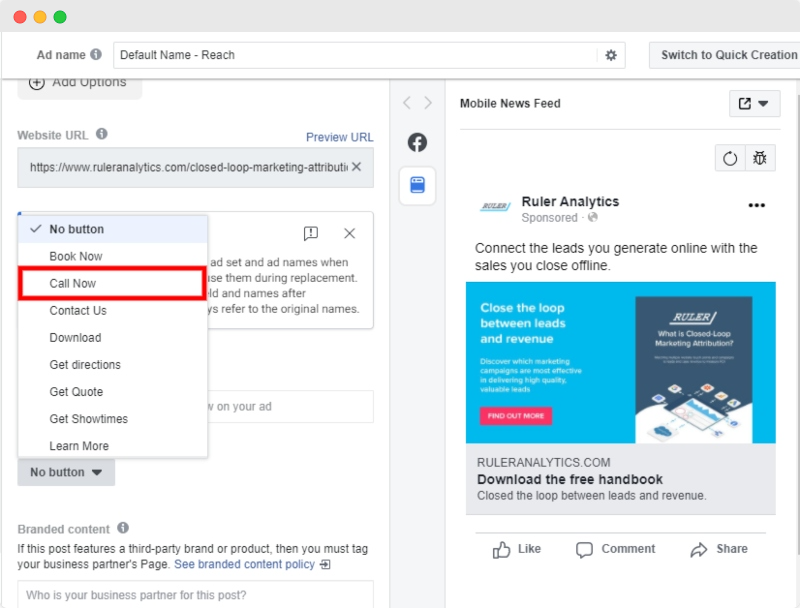
Step 11: Enter your number here. For the best performance, invest in campaign call tracking numbers.
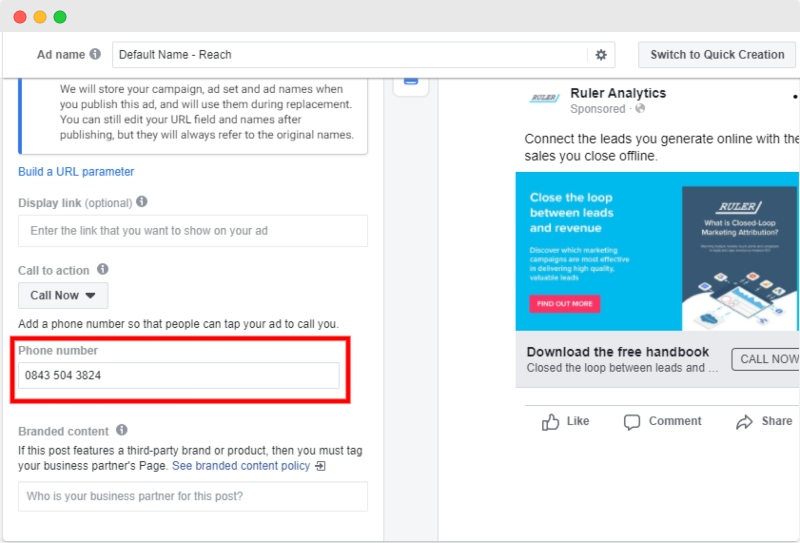
Once you’ve added your number, scroll down and hit “Confirm“.
You’re now ready to generate calls using your Facebook ads.
Creating your ad is the first step towards maximising your ROI. Here are five tips to set you up for success and help get the most out of your Facebook click to call ads.
Take advantage of Facebook’s detailed targeting capabilities to display ads to your ideal customers. Also, make sure to utilise location targeting to get your ads in front of people who are near the business you’re promoting.
To do this, you’ll need to establish an ad lifetime budget rather than a daily budget.
However, being able to narrow the window when your ads display, such as displaying a restaurant ad a couple of hours before dinner, will help you reach people at the moment that they’re seeking your services.
Does including an image encourage or discourage more clicks on your call button? What about including a video instead of an image?
The only way to find out which versions of your ads generate the most impressions, clicks and calls is to test multiple versions and discover the top performers.
Don’t overdo it though. Only test one element at a time. For example, if you decide to test different ad copy variations, make sure that you use the same ad headline and image so that you don’t skew your data.
Using a call tracking number, you can effectively associate your Facebook ad to a specific phone call. With most call tracking providers, you can listen back to the nature of the call and determine the quality.
While call tracking is an essential tool when it comes to marketing measurement, there are many unanswered questions about how it works.
💡 Pro Tip
Ruler is a great tool for tracking inbound phone calls. It provides a full view of your customer journeys and automatically attributes revenue back to the marketing touchpoints that generated the initial phone call.
How does Ruler’s call tracking work?
If you’re a local business, or one who relies on trade through the more old-school route of phone calls, then call tracking is a tool you need.
Our team of attribution experts can talk you through Ruler to help you understand the real ROI of your Facebook call-to-click adverts.
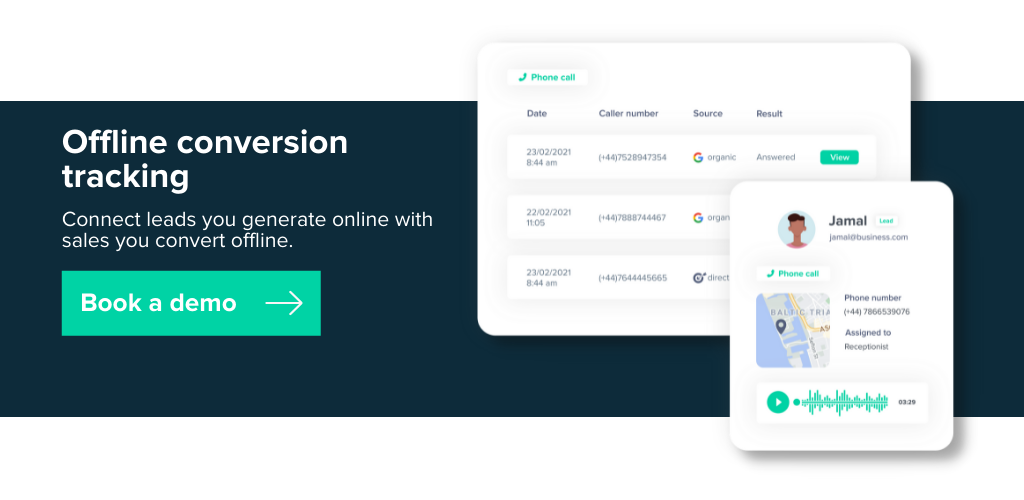
This article was originally publish in 2017 and last updated on 19th April 2022